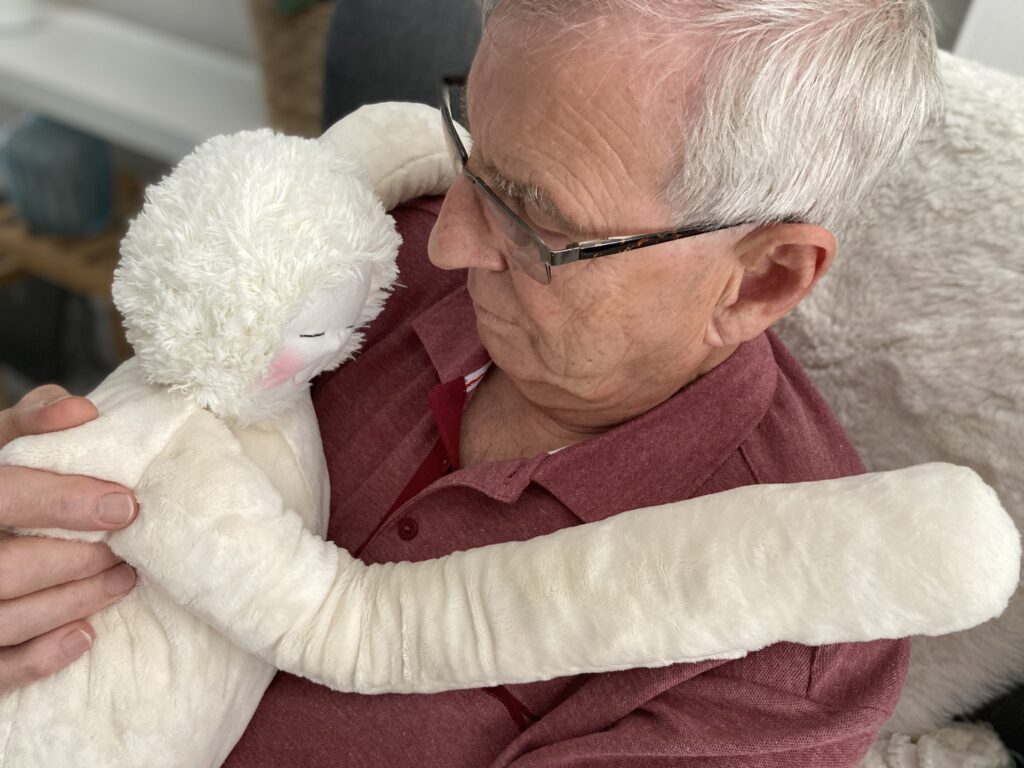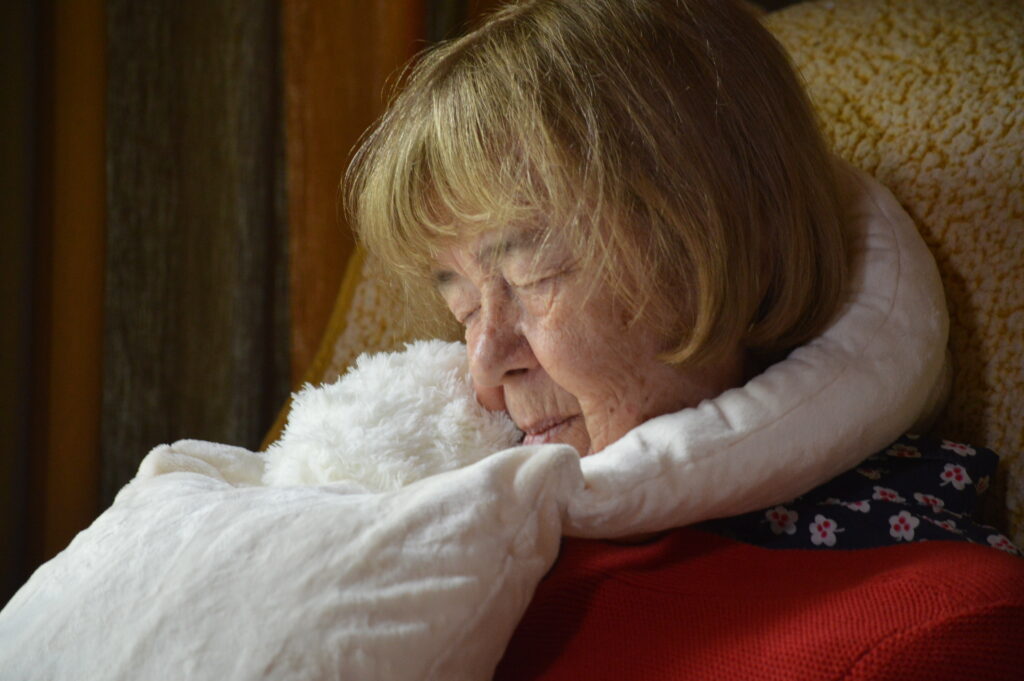Interview: HUG by LAUGH — the science of teddy bears for people living with dementia
A simple idea to help people living with dementia is backed by sophisticated research and technology. We spoke to managing director Dr Jac Fennell and research director Professor Cathy Treadaway at HUG by LAUGH about compassionate design and the health benefits of a good hug…
What is a HUG?
Professor Cathy Treadaway: It’s a sensory product we’ve developed, like a teddy bear with weighted arms and feet. When you snuggle up to it, it gives the sensation of hugging you back. It’s also soft and comforting.
We’ve developed the HUG to help people living with dementia. Touch is very important, especially if you’re cognitively disabled in some way. Human beings have an inbuilt need to want to show and feel affection.

A care home resident benefitting from a HUG, photo courtesy of HUG by LAUGH.
So where does the technology come in?
Professor Cathy Treadaway: A device inside the HUG pulsates with a regular heartbeat, which can help to calm people – we’ve been advised by NHS medics on the rhythm. The device also plays music, which can have a magical effect, bringing back happy memories. It doesn’t have to be music: it can be poetry or a story, a family member’s voice or children’s laughter, whatever best suits the person. It’s easy to put sound files on the device, using a simple drag-and-drop function.
Dr Jac Fennell: Our latest version of HUG also has Bluetooth and can run streaming applications such as Spotify. That came directly from seeing how it was used by carers. They needed to be able to quickly change the music or adjust volume. Technology means we can make HUG better at connecting people to others and the world around them.
Where did the idea come from?
Dr Jac Fennell: Cathy led the research behind the HUG product, which came from LAUGH research at Cardiff Metropolitan University, funded by AHRC, which started in 2015.
Professor Cathy Treadaway: I’d been researching creative practice and found that touch was very important to the health of artists and designers. At the same time, my father was in a care home and I could see how touch and playfulness could bring him joy. I also saw people there who had nothing to do. They had time for playful activities but sat in a chair and did nothing.
That led to the LAUGH project — the acronym stands for Ludic Artefacts Using Gesture and Haptics, where ‘ludic’ means spontaneously playful and ‘haptic’ means the sensation of touch. It was about creating playful, handheld objects. AHRC funded us for three years to look at how we could design things to help people living with advance dementia, as so many people now live into the later stages of the disease.

A man with a HUG, photo courtesy of HUG by LAUGH
Dr Jac Fennell: Six individuals living with dementia were selected, and the project aimed to design a prototype product to support each of them. That approach led to a theory of ‘compassionate design’, the idea being to help other designers work mindfully with people living in the advanced stages of dementia. It’s about putting the person at the centre of the design process.
So the HUG was one of these six prototype projects.
Professor Cathy Treadaway: Yes. It was designed for a woman called Thelma and had an amazing impact on her. We could quickly see the potential for helping other people. The Welsh government funded us for a further three years, 2018-21, and we undertook an evaluation of 40 HUGs in an NHS hospital and care home in Cardiff. Both studies were very positive, showing a clear need for this kind of product. We applied to the Alzheimer’s Society which runs an accelerator funding scheme to help get products to market that will help people living with dementia.
Dr Jac Fennell: With support from that scheme, we launched a spin-out company from the university, which I lead with Cathy as research director and Aidan Taylor as technical director. We worked with the Alzheimer’s Society and focus groups on developing the HUG prototype into a product to go to market. With Alzheimer’s Society funding and a crowdfunding campaign, we were able to launch HUG as a product at the end of 2021.
Professor Cathy Treadaway: The partnership also means that every HUG sold helps raise money for the Alzheimer’s Society to fund further dementia research and innovation.
How successful was the launch of HUG?
Dr Jac Fennell: As Cathy said, there’s been huge demand. We sold out our first batch within a couple of months. HUGs are being used across the UK and we’re exporting to Canada, North America, Australia, New Zealand and some European countries. They’re used by individuals at home and by care homes and hospitals.
Professor Treadaway: In our UK evaluation, HUGs were available on prescription in the NHS.
Are many hospitals now using HUGs?
Dr Jac Fennell: It’s difficult to keep track! Some trusts are rolling out HUGs to provide supportive care in different contexts. Aneurin Bevan University Health Board is just coming to the end of a trial of 500 HUGs used with not just people living with dementia but also children, and those who have autism and learning disabilities. We’re starting to see the benefits of HUG beyond dementia. It’s having a big impact on people’s well-being.
How do you measure the effectiveness of a hug?
Professor Cathy Treadaway: The study undertaken in the care home was done by a consultant occupational therapist using the Pool Activity Level (PAL) system.
Dr Jac Fennell: That’s the standard assessment tool for cognitive and functional ability used in occupational therapy. It was created by Jackie Pool, who we’ve been lucky enough to collaborate with on this. Carers already carry out this kind of assessment of people in their care so it meant that they could directly measure the impact of HUG.
Professor Cathy Treadaway: That study was conducted over six months and showed levels of engagement in quite fine-grained detail. In addition, the Bradford Dementia Group well-being profile also gave positive and negative indicators.
What did these assessments show?
Professor Cathy Treadaway: We published the results in academic papers. [Such as ‘HUG: A Compassionate Approach to Designing for Wellbeing in Dementia Care’ (2023) in the International Journal of Environmental Research and Public Health, and the research section of the HUG by LAUGH website.]
But for example, of those people who had HUG for six months, 87% showed an increase in well-being, which is really significant. Some of those also showed an increase in cognitive and functional ability, as judged by the Pool instrument. That’s incredible because the trajectory of people living with dementia is usually all downhill. We saw improvement in what people could do. Jackie Pool has been in this business for years and is an expert. She was convinced by the effectiveness of this.
Not everybody likes hugs and our research shows that this product doesn’t work for everybody. But where it does, it’s extremely powerful. In the hospital study, they found that it significantly reduced anxiety, which is a big deal when people go into hospital as it can be such a strange and alien place, especially for somebody living with dementia. Anything that can ease anxiety is good but medication can be an issue with older people or those living with dementia. Potentially, it can have the side effect of sedating them, so they’re more likely to suffer a fall. With HUG, patients benefit from a non-medical intervention.

A patient sleeping with a HUG, photo courtesy of HUG by LAUGH
You say it doesn’t work for everyone. Has there been any resistance to what you’ve been doing?
Professor Cathy Treadaway: There was some scepticism when we started. I think people really learned in the pandemic how important it us for us all to be connected.
We get some pushback from people saying, ‘We don’t need a technological doll giving hugs; we need real hugs from real people.’ In fact, we absolutely agree with that. This technology isn’t about providing something instead of human interaction. It’s about making interactions with carers and other people easier, so there is more of it. A carer can’t be there all the time. HUGs bridge the gap.
You must have tested different levels of weight in the hands and feet of the HUG. What makes the best hug?
Dr Jac Fennell: It’s different for everybody. We had to go for a standard weight so it was trial and error. Many people using a HUG will be in bed or using a wheelchair, so it’s not like a weighted blanket which can be quite heavy. We were very careful to ensure that it’s just enough to give you that sense of reciprocated touch.
Where would you like this technology to go next?
Professor Cathy Treadaway: One priority is to make the technology invisible. There’s nothing more off-putting than to have to fumble around for passwords or how to make it work. That’s not just the people living with dementia. Carers are too busy for that. It has to be invisible and intuitive.
Dr Jac Fennell: I’d like to see more of what we’re already doing with other products. HUG is a simple idea executed in an accessible way. There’s so much designers can do with comfort and connection to produce things like HUG. Technology means we can personalise products, such as adding people’s favourite music, that helps people better connect to them.
Professor Treadaway: HUG was only one of the six products we came up with. Five others had potential. But it takes such a lot of time, effort, skill and money to get something like this to market. It’s a huge undertaking for this kind of demographic, where it has to be safe and compliant with regulations. But there’s so much more we can do.
Professor Treadaway and Dr Fennell, thank you very much.
Interview: AR app ‘Dorothy’ helps people living with dementia













Leave a Reply